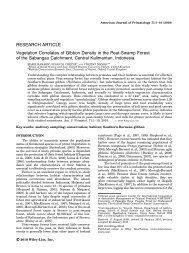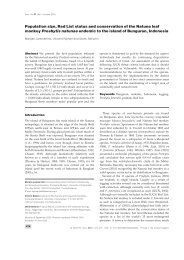Seasonal variation in naturally occurring mobbing ... - Vincent Nijman
Seasonal variation in naturally occurring mobbing ... - Vincent Nijman
Seasonal variation in naturally occurring mobbing ... - Vincent Nijman
You also want an ePaper? Increase the reach of your titles
YUMPU automatically turns print PDFs into web optimized ePapers that Google loves.
30 V. <strong>Nijman</strong><br />
0.86 for Javan hawk-eagle and black eagle respectively). However, the response of<br />
the Javan hawk-eagle towards the mobb<strong>in</strong>g behaviour of the drongos showed a tendency<br />
to differ between the seasons (Mann-Whitney U, N 1 = 2, N 2 = 9, P = 0.08),<br />
with actively avoid<strong>in</strong>g and defend<strong>in</strong>g be<strong>in</strong>g relatively more common dur<strong>in</strong>g the<br />
breed<strong>in</strong>g season. This may suggest either more <strong>in</strong>tense mobb<strong>in</strong>g dur<strong>in</strong>g the breed<strong>in</strong>g<br />
season by drongos or, alternatively, a seasonal difference of motivation of Javan<br />
hawk-eagles towards attacks.<br />
DISCUSSION<br />
Both species of eagle range over large areas, with homeranges <strong>in</strong> the order of<br />
10-30 km 2 (VAN BALEN et al. 2001, NIJMAN 2004) and occur at low population densities.<br />
Dur<strong>in</strong>g the 300-days <strong>in</strong> the field, on average 39 m<strong>in</strong> day –1 were <strong>in</strong> contact with<br />
the eagles dur<strong>in</strong>g which, on average, 0.14 mobb<strong>in</strong>g attacks hr –1 were recorded.<br />
Hence, although drongos are widely reported to frequently mob raptors, mobb<strong>in</strong>g<br />
of Javan hawk-eagle and black eagle was a relatively rare occurrence. As a consequence,<br />
sample sizes <strong>in</strong> the present study were small, but nevertheless allow the<br />
ma<strong>in</strong> research questions to be answered. Due to difficulties associated with study<strong>in</strong>g<br />
mobb<strong>in</strong>g <strong>in</strong> free-liv<strong>in</strong>g species <strong>in</strong> a ra<strong>in</strong>forest environment larger sample sizes<br />
will be difficult to obta<strong>in</strong>.<br />
Contrary to the prediction from the nest/offspr<strong>in</strong>g defence hypothesis, black<br />
eagles were not more frequently attacked than Javan hawk-eagles, nor was there a<br />
difference apparent <strong>in</strong> the <strong>in</strong>tensity of the attacks by drongos towards the two<br />
eagles. Other studies have found clear differences <strong>in</strong> mobb<strong>in</strong>g response towards<br />
different predators. ARNOLD (2000) found a higher mobb<strong>in</strong>g <strong>in</strong>tensity for noisy<br />
m<strong>in</strong>ers towards a stuffed predator of nests and adults (brown falcon Falco berigora)<br />
and a novel bird (brown dove Macropygia ambo<strong>in</strong>ensis) compared to a predator<br />
on nests only (Torresian crow Corvus orru). Likewise, SLAGSVOLD (1985) found<br />
mobb<strong>in</strong>g response of hooded crow C. corone to differ between three different<br />
stuffed predators.<br />
Several studies of mobb<strong>in</strong>g behaviour have noted an association between this<br />
behaviour and reproductive activity (CURIO 1978, SHEDD 1982). Only for the Javan<br />
hawk-eagle did the number of attacks <strong>in</strong>crease dur<strong>in</strong>g the drongo’s breed<strong>in</strong>g season.<br />
The will<strong>in</strong>gness of drongos to mob Javan hawk-eagles more dur<strong>in</strong>g the breed<strong>in</strong>g<br />
season than dur<strong>in</strong>g the non-breed<strong>in</strong>g season, probably stems from at least three<br />
factors: (1) drongos are more aggressive at this time than dur<strong>in</strong>g other times of the<br />
year and lack the option of easy relocation away from predators on their territories,<br />
(2) birds are likely to have eggs or young on their territories (cf. SHEDD 1982)<br />
and (3) if the Javan hawk-eagles have a greater need for prey to feed their offspr<strong>in</strong>g<br />
dur<strong>in</strong>g the drongo’s breed<strong>in</strong>g season, they <strong>in</strong> fact may pose a greater threat to drongos<br />
than at other times of the year (S. VAN BALEN <strong>in</strong> litt.). It should be noted, however,<br />
that although significantly more nests were found dur<strong>in</strong>g April-June, breed<strong>in</strong>g<br />
has been observed dur<strong>in</strong>g all months. Attacks dur<strong>in</strong>g the “non-breed<strong>in</strong>g period”<br />
may reflect a small number of birds hav<strong>in</strong>g a nest or may <strong>in</strong>dicate a base-l<strong>in</strong>e level<br />
of mobb<strong>in</strong>g that is present all-year round.<br />
Black eagles seem to be attacked all-year round, and the number of attacks<br />
was actually higher dur<strong>in</strong>g the non-breed<strong>in</strong>g season, albeit non-significantly. Unlike<br />
many temperate areas, many species <strong>in</strong> the tropical ra<strong>in</strong> forests of Java are proba-










